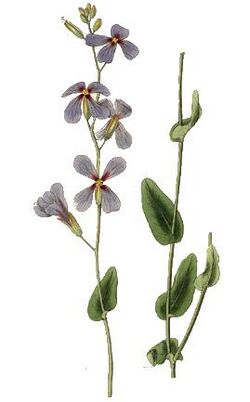Biology:Moricandia
| Moricandia | |
|---|---|

| |
| Moricandia arvensis | |
| Scientific classification | |
| Kingdom: | Plantae |
| Clade: | Tracheophytes |
| Clade: | Angiosperms |
| Clade: | Eudicots |
| Clade: | Rosids |
| Order: | Brassicales |
| Family: | Brassicaceae |
| Genus: | Moricandia DC. |
| Species | |
|
See text | |
Moricandia is a genus of plants of the family Brassicaceae. This genus is mainly distributed in North Africa, the Middle East, and Southern Europe. It is associated with arid and semi-arid environments. Flowers of this genus are actinomorphic-dissymmetrical and mostly lilac in color, although they vary from white to purple depending on the species and climatic conditions. Some species show extreme phenotypic plasticity for flower size, shape, and color.[1] The fruits are two-valved dehiscent siliques with one or two sets of seeds per valve.[2]
Moricandia shows high variability in the morphological characters used for identification, making this genus's taxonomy complex and, many times, controversial.[3] Eight species with a variable number of synonymies and subspecies are actually accepted.[4] Moricandia arvensis also known as purple mistress is the most widely distributed species of this genus. Moricandia moricandioides commonly known as violet cabbage, a native of the Mediterranean, is cultivated as a garden flower.
Some species of this genus perform C2 photosynthesis,[5] making them interesting in the engineering of C2 crops.[6]
Species
- Moricandia arvensis (L.) DC.
- Moricandia foetida Bourg. ex Coss.
- Moricandia moricandioides (Boiss.) Heywood
- Moricandia nitens (Viv.) Durieu & Barr
- Moricandia rytidocarpoides Lorite, Perfectti, Gómez, González-Megías & Abdelaziz[7]
- Moricandia sinaica Boiss.
- Moricandia spinosa Pomel.
- Moricandia suffruticosa (Desf.) Coss. & Durieu
Previously considered a Moricandia species, M. foleyi Batt. is now ascribed to the genus Eruca as Eruca foleyi based in phylogenetic analyses[8]
References
- ↑ Gómez, JM.; Perfectti, F.; Armas, C.; Narbona, E.; González-Megías, A.; Navarro, L.; DeSoto, L.; Torices, R. (2020). "Within-individual phenotypic plasticity in flowers fosters pollination niche shift". Nature Communications 11 (1): 4019. doi:10.1038/s41467-020-17875-1. PMID 32782255. Bibcode: 2020NatCo..11.4019G.
- ↑ Gupta, S. K. (2016). Biology and breeding of crucifers. Boca Raton: CRC Press.. ISBN 978-1-4200-8608-9.
- ↑ Jiménez, J. F.; Sánchez-Gómez, P. (2011). "Molecular taxonomy and genetic diversity of Moricandia moricandioides subsp. pseudofoetida compared to wild relatives". Plant Biosystems 146 (1): 99–105. doi:10.1080/11263504.2011.579191. https://www.tandfonline.com/doi/abs/10.1080/11263504.2011.579191. Retrieved 27 December 2021.
- ↑ "Kew Royal Botanical Garden". https://powo.science.kew.org/taxon/urn:lsid:ipni.org:names:12813-1#source-KB.
- ↑ Schlüter, Urte; Bräutigam, Andrea; Gowik, Udo; Melzer, Michael; Christin, Pascal-Antoine; Kurz, Samantha; Mettler-Altmann, Tabea; Weber, Andreas PM (January 2017). "Photosynthesis in C 3 –C 4 intermediate Moricandia species". Journal of Experimental Botany 68 (2): 191–206. doi:10.1093/jxb/erw391. PMID 28110276.
- ↑ Adwy, W; Laxa, M; Peterhansel, C (December 2015). "A simple mechanism for the establishment of C₂-specific gene expression in Brassicaceae.". The Plant Journal 84 (6): 1231–8. doi:10.1111/tpj.13084. PMID 26603271.
- ↑ "Moricandia rytidocarpoides Lorite, Perfectti, J.M.Gómez, Gonz.-Megías & Abdelaziz". https://www.gbif.org/es/species/10718082.
- ↑ Perfectti, F.; Gómez, J.M.; González-Megías, A.; Abdelaziz, A.; Lorite, J. (2017). "Molecular phylogeny and evolutionary history of Moricandia DC (Brassicaceae)". PeerJ 5: e3964. doi:10.7717/peerj.3964. PMID 29093999.
External links
- Moricandia DC. by E. Sobrino Vesperinas
- Evoflor, a web page on Moricandia floral evolution
Wikidata ☰ Q2884408 entry
 |

